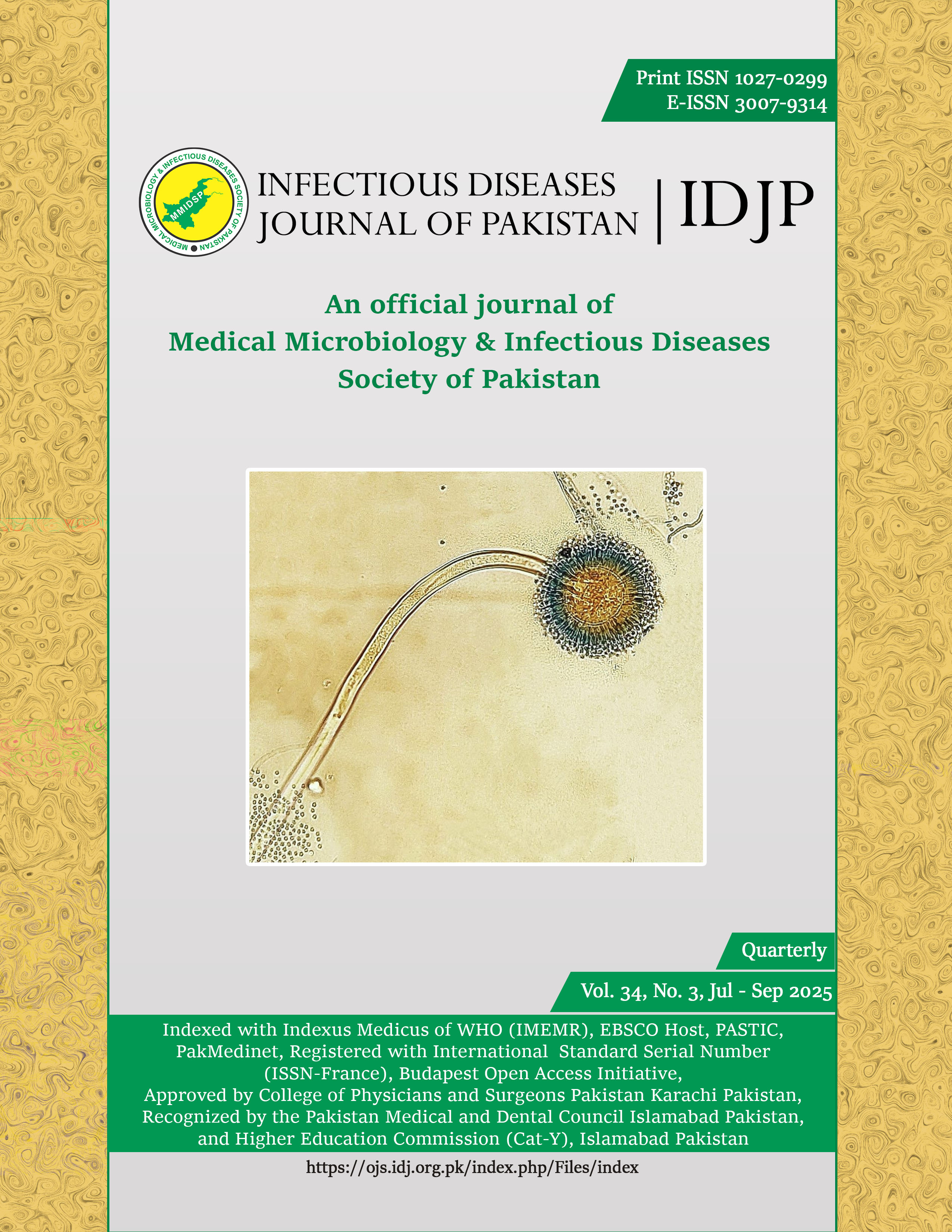Endemicity of dengue in Mamund Subdivision, District Bajaur, Pakistan, in 2022
DOI:
https://doi.org/10.61529/idjp.v34i3.363Abstract
Background: Dengue, a rapidly rising mosquito-borne viral disease, threatens nearly half of the global population. It is endemic in many regions of Pakistan, including Khyber Pakhtunkhwa. Despite frequent reports from Mamund, District Bajaur, its endemic status has not been evaluated, raising the question of whether cases originate locally or are imported.
Material and Methods: A descriptive cross-sectional study was conducted at Government Category-D Hospital Mamund from September to December 2022. A total of 230 patients aged 10–70 years with suspected or confirmed dengue were enrolled through consecutive non-probability sampling. Data on demographics, travel history, and dengue NS1 results were collected, while patients without consent, outside the age range, or lacking NS1/travel history were excluded. Analysis was performed using SPSS.
Results: Of the 230 patients, 144 (62.6%) were male and 86 (37.4%) female. Mean age was 30.9 ± 11 years. Travel history outside Mamund was present in 129 (56.1%) and absent in 101 (43.9%). NS1 positivity was found in 110 patients (47.8%), all of whom had recent travel history. No patient without travel history tested NS1 positive. The association between travel history and NS1 positivity was statistically significant (p < 0.001).
Conclusion: Dengue cases in Mamund subdivision appear imported, with no evidence of endemic local transmission. Findings emphasize the need for vector surveillance studies to confirm the presence or absence of Aedes mosquitoes in Mamund and to guide preventive strategies.
Keywords: Aedes, Bajaur, Dengue, Endemicity, Epidemiology, Mamund, NS1 Protein, Pakistan.
References
WHO. Dengue and severe dengue [Internet]. Geneva: World Health Organization; [cited 2023 Mar 7]. Available from: https://www.who.int/news-room/fact-sheets/detail/ dengue-and-severe-dengue
Wilkinson IB, Raine T, Wiles K, Goodhart A, Hall C, O'Neill H. Oxford handbook of clinical medicine. 10th ed. Oxford: Oxford University Press; 2017. Chapter 9, Infectious diseases; p. 420. DOI: https://doi.org/10.1093/med/9780199689903.003.0009
Chaterji S, Allen JC Jr, Chow A, Leo YS, Ooi EE. Evaluation of the NS1 rapid test and the WHO dengue classification schemes for use as bedside diagnosis of acute dengue fever in adults. Am J Trop Med Hyg. 2011; 84(2): 224-8. DOI: https://doi.org/10.4269/ajtmh.2011.10-0316
CDC. Dengue virus antigen detection (NS1) [Internet]. Atlanta: Centers for Disease Control and Prevention; [cited 2023 Mar 11]. Available from: https://www.cdc.gov/dengue/healthcare-providers/testing /antigen-detection.html
Tayal A, Kabra SK, Lodha R. Management of dengue: an updated review. Indian J Pediatr. 2023; 90(2): 168-77. DOI: https://doi.org/10.1007/s12098-022-04394-8
Bhatt S, Gething PW, Brady OJ, Messina JP, Farlow AW, et al. The global distribution and burden of dengue. Nature. 2013; 496(7446): 504-7. DOI: https://doi.org/10.1038/nature12060
WHO. Dengue-Pakistan [Internet]. Geneva: World Health Organization; [cited 2023 Mar 8]. Available from: https://www.who.int/emergencies/disease-outbreak-news/item/2022-DON414
WHO. Pakistan: dengue fever. The current epidemic [Internet]. Cairo: World Health Organization Regional Office for the Eastern Mediterranean; [cited 2024 Jun 19]. Available from: https://www.emro.who.int/pak/programmes/dengue-fever.html
Khattak A, Khan S, Ali I, Gul A, Khabir MN, Javed B, et al. Burden and distribution of dengue infection in Pakistan (2000-19): a review. Braz J Biol. 2024; e267982. DOI: https://doi.org/10.1590/1519-6984.267982
Government of Khyber Pakhtunkhwa. About Khyber Pakhtunkhwa [Internet]. Peshawar: KP Government; [cited 2024 Jun 18]. Available from: https://kp.gov.pk/page_type/message/page/welcome
Suleman M, Faryal R, Alam MM, Sharif S, Shaukat S, Aamir UB, et al. Dengue virus serotypes circulating in Khyber Pakhtunkhwa province, Pakistan, 2013-2015. Ann Lab Med. 2017; 37(2): 151-4. DOI: https://doi.org/10.3343/alm.2017.37.2.151
Khan J, Adil M, Wang G, Tsheten T, Zhang D, Pan W, et al. A cross-sectional study to assess the epidemiological situation and associated risk factors of dengue fever; knowledge, attitudes, and practices about dengue prevention in Khyber Pakhtunkhwa Province, Pakistan. Front Public Health. 2022; 10: 923277. DOI: https://doi.org/10.3389/fpubh.2022.923277
Pakistan Bureau of Statistics. Population census: district-wise tables, Bajaur [Internet]. Islamabad: Government of Pakistan; [cited 2023 Mar 9]. Available from: https://www.pbs.gov.pk/census-2017-district-wise/results/032
Ahmad N, Khan T, Jamal SM. A comprehensive study of dengue epidemics and persistence of anti-dengue virus antibodies in District Swat, Pakistan. Intervirology. 2020 ;63(1-6): 46-56. DOI: https://doi.org/10.1159/000510347
Gul R, Tabassum I, Ullah I, Rahman F. Incidence of dengue in the highland district Swat, Pakistan: A major shift in the geographical prevalence of the disease. Proc Pak Acad Sci B Life Environ Sci. 2019; 56(2): 27-38. Available from: https://paspk.org/wp-content/uploads/2020/02/LS-523.pdf
Tanzila G, Rasheed SB, Khan NH, Kausar A, Jahan F, Wahid S. Insecticide susceptibility and detection of kdr-gene mutations in Aedes aegypti of Peshawar, Pakistan. Acta Trop. 2023; 242: 106919. DOI: https://doi.org/10.1016/j.actatropica.2023.106919
Mohamud MA, Qazi U, Latif A, Khan IU, Anwar S. Dengue outbreak response and control in Khyber Pakhtunkhwa, Pakistan: A mixed methods study. J Epidemiol Glob Health. 2020; 10(1): 74-81. DOI: https://doi.org/10.2991/jegh.k.191125.001
World Health Organization. Dengue fever – Pakistan. Outbreak update 2019. WHO Disease Outbreak News [Internet]. Geneva: World Health Organization; [cited 2025 Sep 17]. Available from: https://www.who.int/emergencies/disease-outbreak-news/item/2019-DON206
Downloads
Published
How to Cite
Issue
Section
License
Copyright (c) 2025 Khan Zeb

This work is licensed under a Creative Commons Attribution-NonCommercial 4.0 International License.



